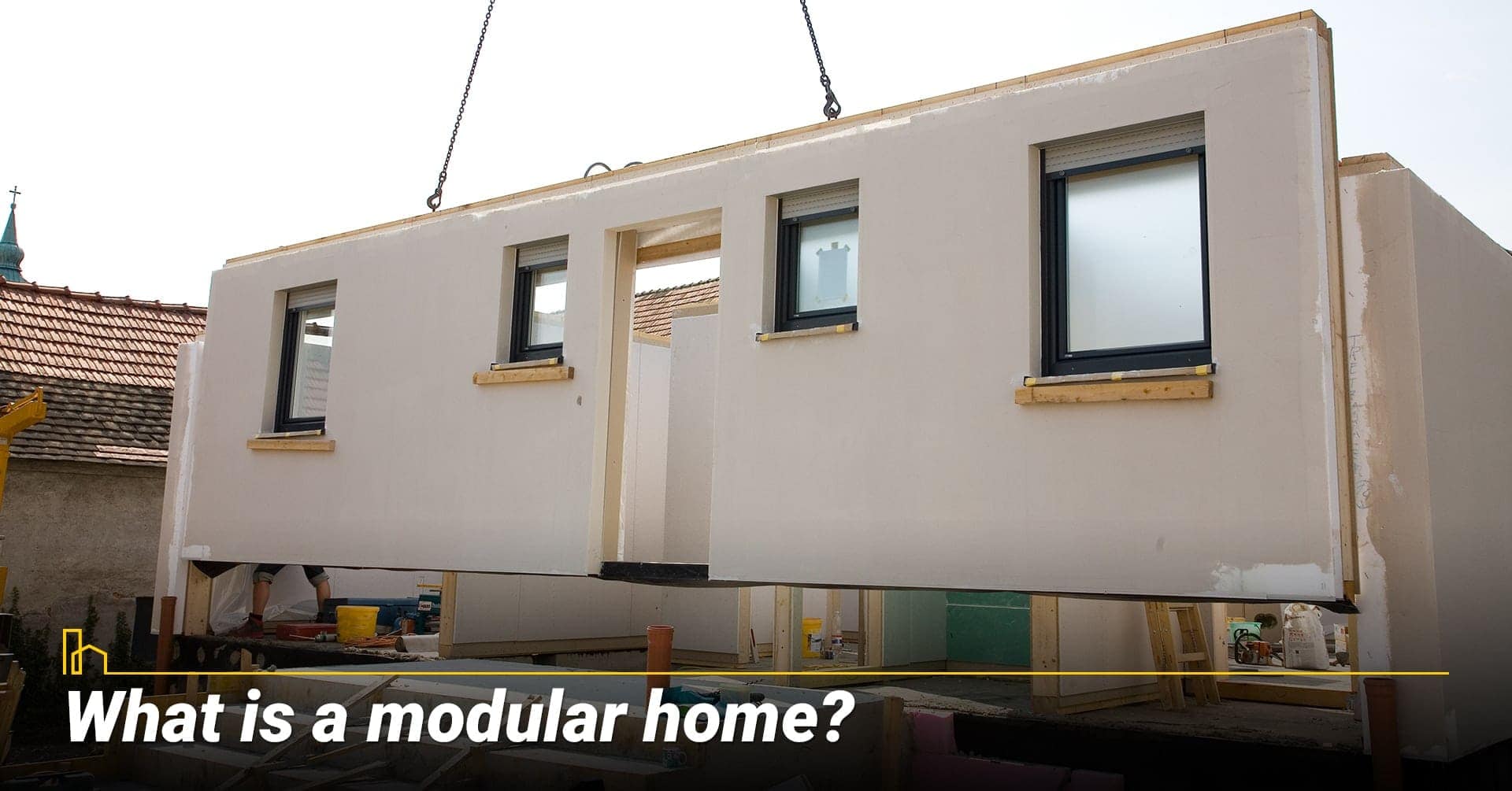Pros & Cons of Modular Homes Investment
- Author:by The HOMEiA Team
- Category: Buy House , Real Estate Investing

More “prefab” than a built-on-site home and more permanent than a mobile home, modular homes are an intriguing option for home buyers. We will explain in detail what the modular home is and its Pros and Cons which you should know before deciding whether it is a good investment for you.
Are modular homes a good investment today? The answer is Yes, modular homes values can increase over time – this makes for a good investment. Proponents see them as an excellent way to build economically and with consistent quality, while detractors find them impersonal and cite their mixed reputations as a reason to stay away.
As with all housing options, there are tradeoffs when choosing a modular home. They’re not for everyone, but for an increasing number who value economy, quick completion, and even quality, a modular home could be a great decision.
Table of Contents:
Pros and Cons of Modular Homes

Modular homes are right for some situations and wrong for others. Even when they’re a great match for your needs, there are some factors you understand before you proceed.
One of the benefits of a modular home is the streamlined process for selection and construction. For many buyers, this is a plus, but if you want to customize each and every aspect in order to create your dream home, you may find your options too limited. A custom stick-built home (with a large budget!) might suit you better.
Next, remember that the price of a modular home does not include everything that the list price of an existing home does. Be sure to add in these costs.
Modular homes, also known as prefab or factory-built homes, are constructed in sections or modules in a factory and then transported to the building site for assembly. Like any housing option, modular homes have their own set of pros and cons:
Pros of Modular Homes:
Cost-Efficient: Modular homes can be more cost-effective than traditional stick-built homes. Factory construction allows for better cost control and reduced material waste.
Faster Construction: Modular homes are typically built much faster than traditional homes. Since much of the construction is done in a controlled factory environment, weather-related delays are minimized.
Quality Control: Factory construction means that each module is built under strict quality control standards, potentially resulting in a higher quality home.
Energy Efficiency: Modular homes can be designed with energy-efficient features and materials, which can lead to lower utility bills in the long run.
Customization: Modular homes offer a wide range of design options and can be customized to meet your preferences and needs. They can be single-story or multi-story, and you can choose from various architectural styles.
Sustainability: Some modular homes are built with sustainable materials and practices, making them more eco-friendly than traditional homes.
Less Disruption: Since much of the construction takes place off-site, there is less disruption to the local neighborhood during the building process.
Cons of Modular Homes:
Land and Permit Challenges: Finding suitable land and navigating local zoning regulations and permits can be challenging, as not all areas are open to modular construction.
Limited Customization: While there is a degree of customization available, modular homes may have limitations compared to completely custom-built homes. Some layouts or design features may be less flexible.
Transportation Costs: Transporting the modules to the building site can be costly, especially if the site is far from the factory.
Foundation Requirements: Modular homes typically require a permanent foundation, which can add to the overall cost.
Resale Value: Modular homes may not appreciate in value as much as traditional homes over time, although this can vary depending on factors such as location and the quality of construction.
Financing Challenges: Securing financing for a modular home can sometimes be more challenging than for a traditional home, as some lenders may have stricter requirements.
Limited Design Changes: Once the modules are constructed, making significant design changes can be difficult and costly.
In summary, modular homes offer a range of advantages, including cost efficiency, speed of construction, and quality control. However, they also come with challenges related to land acquisition, customization, and financing. Whether a modular home is the right choice for you depends on your specific needs, budget, and the local housing market. It’s essential to research and carefully consider your options before making a decision.
Recommended for you
What is a Modular Home?

First, it helps to know what a modular home is not.
A modular home is not a “stick-built” home—industry jargon for a house built on-site, from the foundation and frame to the shingles and siding. Stick-built homes are the most traditional, and account for the vast majority of new construction done today. They require all the workers and all the materials to travel to the build site.
On the other hand, a modular home is not a mobile home. Mobile homes are manufactured entirely in the factory and transported to their locations on wheels. The standard long, narrow appearance of a “single-wide” mobile home owes to the need for it to fit roughly within a lane of highway.
Double- and triple-wides are transported in two or three pieces and end up with proportions more similar to a typical ranch home. They are generally placed without a foundation, though they may have skirting to connect the exterior walls with the ground.
Modular homes fill a niche between stick-built and mobile. Sections of the home are built in a factory. They are brought to the build site, where local contractors assemble and finish them.
Modular homes are assembled on a foundation, which may include a traditional basement, and the completed home may be largely indistinguishable from a stick-built home.
5 Best Places to Live in Texas
Each of the five large cities described are chock-full of neighborhoods that are favored by families with children, young professionals, and retirees. We’ll focus on eight critical attributes that often define a city: History and population, Lifestyle, Affordability, Housing market and neighborhoods, Healthcare and safety, Employment…
Best of Both Worlds

At their best, modular homes take advantage of some of the best features of site-built and manufactured homes.
Because they are built at a factory, where materials are already available and workers are already onsite, modular homes can be very cost-effective. Manufacturers can take advantage of economies of scale by creating many similar buildings in the same place—think shared equipment instead of duplicates, bulk materials and significantly less transportation time.
They can also be built quickly. Most of the building is done indoors, where weather won’t halt construction work. Even inspections require less time, as they’re done on site. Once the modules are ready and brought to the homesite, they can be combined quickly into a complete home.
Factory-built housing may suffer from a false impression that, being less expensive, it is also lower in quality. But modern modular homes actually benefit from their assembly line process. The modules of the homes are built under strict observation from quality control; sloppy work won’t go unnoticed as it could at a remote build site.
Additionally, the pieces of the structure must be strong enough to be carried long distances without damage, so the bar is higher almost by definition.
What about building codes? While mobile homes follow the national building code from the U.S. Department of Housing and Urban Development, modular homes are held to the same local building codes as a stick-built home, and manufacturers design their buildings with that in mind.
As an added bonus, modular homes are designed to be very energy-efficient, reducing your environmental footprint and shrinking your energy bills.
10 Best Places to Live in Virginia in 2024
Virginia is an amazing place. Where else can you find mountains and beaches, high-end horse-racing communities and small towns with neighbors who travel by wagon — all within a two-hour drive?…
Financing Your Modular Home

In part due to a lack of education about the quality of today’s prebuilt homes, it has been more difficult to get a loan for a modular home than for a traditionally built home—but that may be changing.
A popular belief that manufactured homes depreciate over time (in contrast to stick-built homes) has not been borne out by experience. Just like traditional homes, modular homes have increased in value over time, meaning they can be a smart investment, too.
The process for obtaining a loan for your modular home differs slightly from that for buying an existing home. In most cases, the loan will have two phases, in what’s known as a “construction-to-permanent” loan.
The loan starts out as a construction loan, and you’ll pay interest only (no principal) until the final appraisal. At that point it becomes a permanent mortgage and you will start to pay down the full loan amount.
The major lenders in the U.S. are offering new ways to finance manufactured homes, too, giving you more options than in the past.
In 2019 Fannie Mae introduced MH Advantage, which can finance manufactured homes as long as they fit in with stick-built houses, meeting requirements such as drywall throughout the home and eaves that are at least six inches. Why the cosmetic requirements? Because lenders can use stick-built homes as comps when determining the value of the home.
The minimum down payment for the program is just three percent, making it a viable option for some first-time and lower income buyers.
Freddie Mac offers loans for manufactured homes as well—specifically the Freddie Mac Home Possible program. To qualify for this program the home has to be defined as “real property” via its title—which usually means it must be permanently attached to the land, as modular homes typically are.
The 10 Best Places to Live in South Carolina for Families
In addition to the coastal beauty of well-known cities like Charleston and Myrtle Beach, South Carolina has an abundance of places across the midlands and the upstate filled with opportunities to enjoy small-town charm or big-city living…
Conclusion
Here is an analogy. In recent years, winemakers have recognized that screw-caps and even wine boxes offer significant benefits over traditional corked bottles—most importantly, they eliminate the problem of “cork rot,” which causes some percentage of their product to go to waste. Consumers, on the other hand, hold on to the idea that corked wine is classier, reducing the demand for the newer bottle styles.
Modular homes are similar. The newest homes are high-quality, high-efficiency, economical and more eco-friendly. They can be assembled so they’re virtually indistinguishable from stick-built homes, and they can have full foundations and basements.
Until public perception catches up with the reality, though, there is some risk that a modular home may be harder to resell when the time comes.
If you only expect to live in your home for a few years, a modular home might not be worth the tradeoff. But if you intend to stay in your home for a long time, a modular home could be a great investment that will stand the test of time.
Pros and Cons of Living in Florida
If you’ve decided to make Florida your new home, you’re in luck – it’s a big and varied place, with something for all ages, family dynamics and budget. Continue reading as we dive into some notable Pros and Cons about the state itself, the top cities to live in across a variety of categories, and…




































































































